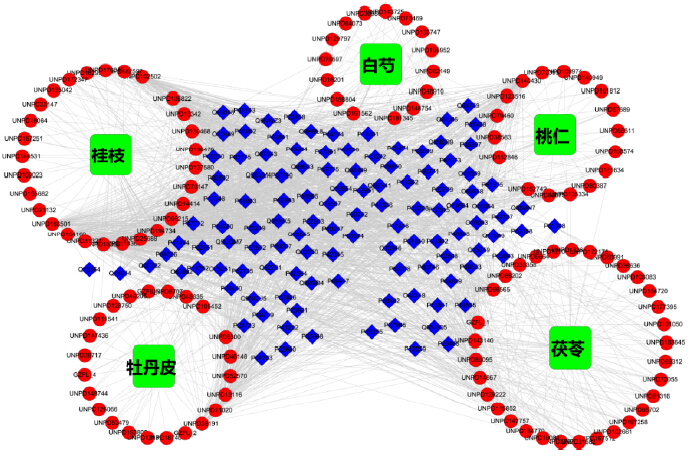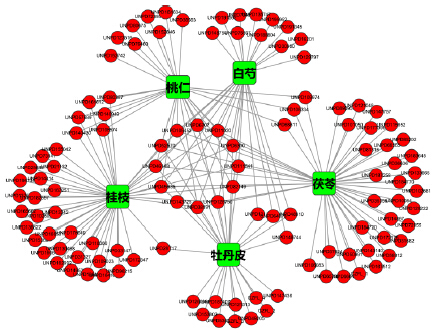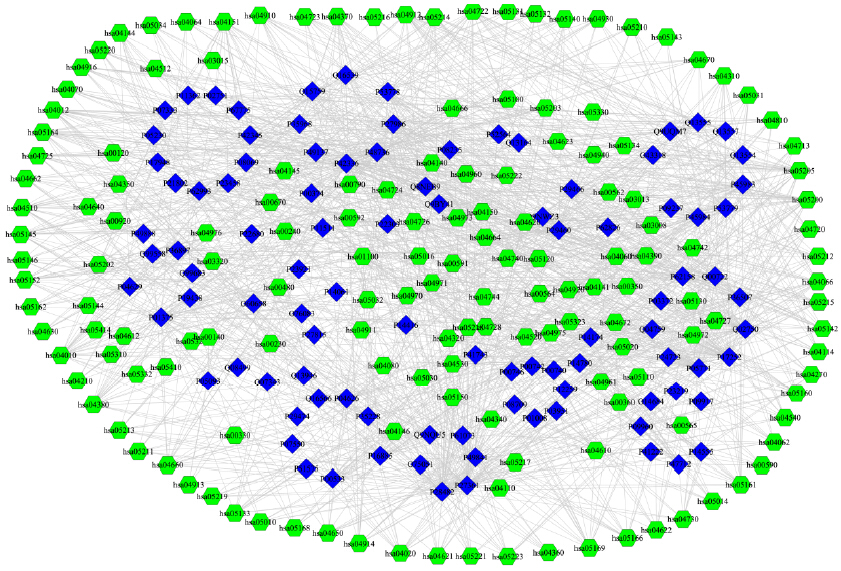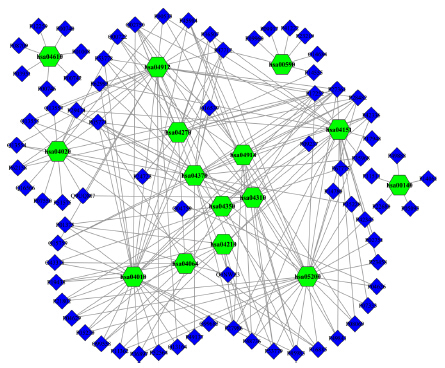2. 北京大学化学与分子工程学院, 北京 100871
2. College of Chemistry and Molecular Engineering, Peking University, Beijing 100871, China
痛经(dysmenorrhea)、盆腔炎(pelvic inflammatory disease,PID)和子宫肌瘤(hysteromyoma)是妇科常见疾病,多见于月经期妇女,疼痛是其主要的临床表现,严重时会影响到患者的工作、学习以及生活质量[1, 2, 3, 4]。目前用于痛经和盆腔炎治疗的药物多是一些非甾体抗炎药(NSAIDS)[5],用于治疗子宫肌瘤的药物主要有孕激素类、纤溶药物、NSAIDS、促性腺激素类似物/拮抗剂(GnRHanalogs/antagonists)[6]等。
由于化学药的不良反应或疗效不理想等问题,近年来从中药中寻找治疗妇科疾病的药物日渐受到重视[5, 7, 8, 9]。桂枝茯苓胶囊是由江苏康缘药业股份有限公司根据经典方桂枝茯苓丸研发的现代中药制剂,其君药桂枝、臣药桃仁、佐以牡丹皮、白芍和茯苓而成,具有活血、化瘀、消癥之功效。临床主要用于妇女瘀血阻络所致癥块、经闭、痛经、产后恶露不尽以及子宫肌瘤、慢性盆腔炎等[10, 11]。虽然前期对桂枝茯苓胶囊的作用机制和化学成分有一些研究[12, 13],但由于中药成分的多样性和作用机制的多靶点、多通路,桂枝茯苓胶囊的主要活性成分和作用机制的实验研究仍面临着诸多挑战。
网络药理学是基于网络观点从系统水平分析药物作用机制[14]、发现先导化合物或新适应症[15]、识别新药靶[16]等一种新的药物研发策略,其与中药整体调控机体的理念相吻合[17]。目前网络药理学研究思路也逐渐被引入到中药中来发现药效物质基础、探索分子作用机制以及阐释其科学内涵[18, 19, 20, 21, 22],同时也能大大降低中药后续实验研究的工作量。因此,本研究将网络药理学研究思路与中药桂枝茯苓胶囊相结合来阐释其治疗痛经、盆腔炎和子宫肌瘤的药效活性成分和可能的分子机制,旨在为后续的实验研究方向选择提供一定的信息支撑。
1 方法 1.1 分子和靶蛋白数据集的建立与处理在前期对桂枝茯苓胶囊中164个化学成分分离确认的基础上[23, 24],根据OpenBabel 2.3.2软件产生的化合物InChiKey字符串从UNPD数据库(http://pkuxxj.pku.edu.cn/UNPD/)共计筛选出172个分子(表 1),经Open Babel加氢后,选用MMFF94力场进行构象优化,优化时能量阈值设定为1×10−3J/mol。
| 表 1 桂枝茯苓胶囊中筛选出的化合物 Table 1 Compounds separated from GFC |
根据桂枝茯苓胶囊的临床主要用于痛经、盆腔炎、子宫肌瘤等妇科疾病的治疗情况,利用Therapeutic Target Database(TTD)、DrugBank数据库结合文献综述分析[6, 8, 9, 25, 26, 27, 28, 29, 30, 31],以dysmenorrhea、hysteromyoma、uterine fibroids(子宫平滑肌瘤)、PID为检索词共筛选与上述疾病密切相关的130个靶点,并从RCSB数据库(www.pdb.org)获取人源的且含有原配体的晶体结构(Resulation<0.25 nm,表 2),导入Discovery Studio 2.5通过CleanProtein和Forcefiled中CHARMm力场完成靶蛋白的加氢、去水、蛋白修饰以及自动分配原子类型和确定活性位点的中心坐标。
| 表 2 与痛经、盆腔炎和子宫肌瘤相关的靶蛋白 Table 2 Target proteinsrelated with dysmenorrhea,PID,and hysteromyoma |
根据上述确定的分子UNPD与靶蛋白的Uniprot,从TCMN数据库[32]中抽提出分子与靶蛋白相互作用数据对。在TCMN数据库中,分子与靶蛋白相互作用通过DOVIS2.0平台中AutoDock4.0内核来完成分子与靶蛋白对接计算[33]。具体对接参数如下:以靶蛋白中原配体的坐标为活性位点的中心,盒子大小为4 nm×4nm×4 nm,格点间隔为0.037 5 nm,采用拉马克遗传算法采集分子构象,初始种群为150,旋转步长为50°,平移步长为0.2 nm,交叉率为0.8,突变率为0.02,局部搜索频率为0.06,其余均为默认设置。
1.3 网络构建与靶蛋白生物通路分析根据分子与蛋白的对接分值,以原配体对接得分为阈值,抽取对接得分较高(score≥5.00)的分子-靶蛋白相互作用数据对导入Cytoscape3.0[34]构建桂枝茯苓胶囊中小分子与靶蛋白相互作用网络,并将网络中小分子进一步投射到相应的药材构建出药材-分子-靶标网络(herb-drug-target network,HDTN)。同时,针对网络中的靶蛋白,进一步投射到KEGG数据库(http://www.genome.jp/kegg/pathway. html)构建出靶蛋白-生物通路网络(target-pathwaynetwork,TPN),从而获得桂枝茯苓胶囊对生物通路的影响。上述网络的构建及网络特征的分析均采用Cytoscape 3.0及其插件NetworkAnalyzer来计算。
2 结果 2.1 网络特征分析在构建的HDTN网络(图 1)中,包含115个分子,116个靶蛋白以及5味中药,平均每个分子靶向17.90个靶蛋白,每个蛋白有17.75个分子,然后利用Cytoscape 3.0中插件NetworkAnalyzer[35]进一步对HDTN网络中分子与靶蛋白间的相互关系网的分析发现,此关系网的平均最短路径为17.827,远小于整个节点数(231),提示分子与靶标的关系网为典型的小世界网络(small world),而从分子与靶标关系网中各节点的度分布服从幂律分布[P(κ)=28.96×κ−0.73(r=0.865)]来看,说明分子与靶标构成的关系网具有良好的稳定性[36, 37],提示桂枝茯苓胶囊中这些活性成分能纠正疾病状态下的机体平衡网络促使其形成新的机体平衡,进而可能起到调控机体的治疗作用[38]。同时,在分子与药材的相互关系分析发现,46个分子来自于君药桂枝、46个分子来自于茯苓,而来自白芍和牡丹皮的分子各有27个,此外还有桃仁的28个分子,其中桃仁与桂枝之间的活性成分有较大的重叠,这也印证了桂枝茯苓胶囊组方的合理性(图 2)。
 | 圆形代表从茯苓桂枝胶囊中筛选的化合物;菱形代表蛋白靶点;圆角矩形代表组方药材 Ellipse represents small molecules from GFC;Diamond represents target proteins; Round rectangle represents herbs图 1 药材-分子-靶点网络 Fig.1 Herb-drug-target network (HDTN) |
 | 图 2 桂枝茯苓胶囊中活性成分在药味归属中的分布 Fig.2 Distribution of activeconstituents from GFC in herbalattribution |
在网络分析中,除了整体网络特征分析,还提出了度(degree)、介数(betweenness)、聚类系数(clustering coefficient)等一系列可定量刻画网络内部结构的度量[39],并已被应用到生物网络中来鉴别可药的靶点[40]、发现药物新适应症[15]、解析药物作用新机制以及活性化合物的发现[14]等,尤其是度、介数常被用于研究分子网络中各节点的重要性。因此,在对HDTN网络的整体拓扑学特征分析的基础上,进一步对网络中各节点的度和介数进行了详细分析,以确定桂枝茯苓胶囊中主要活性化合物和潜在的靶蛋白。
从HDTN网络中分子节点的网络度和介数来看(表 3、4),67个分子(35个化合物)可与6个以上的靶蛋白相互作用,其中网络度和介数较高的分子多数为五环三萜类化合物和甾醇类化合物,如柠檬甾二烯醇(citrostadienol)、菜油甾醇(campesterol)、麦角甾醇(ergosterol)、去氢茯苓酸(dehydropachymic acid)、茯苓酸(pachymic acid)、去氢土莫酸(dehydrotumulosic acid)、ergosta-4,6,8 (14),22-tetraen-3-one、齐墩果酸(oleanolic acid),还有部分黄酮类化合物如槲皮素(quercetin)、芹菜素(apigenin)。而文献分析也发现,ergosta-4,6,8 (14),22-tetraen-3-one、oleanolic acid、polyporenicacid C、eburicoic acid 和dehydroeburicoic acid能明显抑制NO、IL-1β和TNF-α[41, 42, 43, 44],β-amyrin acetate具有镇痛和抗炎活性[45, 46],campesterol可抑制血管形成[47],与用于治疗子宫肌瘤的Progesterone受体激动剂和调节剂药物有类似的结构的甾醇类化合物也被报道治疗多种癌症[6, 8, 48],黄酮类化合物与用于子宫肌瘤治疗的genistein、isoliquiritigenin等化合物有类似的结构,且槲皮素已被作为有可能治疗子宫肌瘤的多酚类化合物被研究,儿茶素类化合物用于癌症的治疗[9, 49]。
| 表 3 HDTN网络中部分节点(化合物)的网络特征 Table 3 Network features of nodes (compoundsfrom GFC) with high degree inHDTN |
| 表 4 HDTN网络中部分节点(靶蛋白)的网络特征 Table 4 Network features of nodes (target proteins) with high degree in HDTN |
在对HDTN5网络中116个靶蛋白节点的网络特征分析发现(表 5),有109个靶蛋白可与6个以上的活性分子存在较强相互作用,其中NOS、collagenase 3、coagulation factor X、GSK、PLA2、FGFR、MMP-9、EGFR、COX等50个靶点可与20个以上的活性分子存在较强相互作用,在这些靶蛋白中,即包括可与NO、PGE2、TNF-α、leukotriene炎症因子的合成与释放炎症因子密切相关的NOS、COX、PLA2、PGES、5-LOX、caspase-1等关键酶、与凝血过程相关的antithrombin-III、coagulation factor XI、coagulation factor VII、cogulation factor X、cogulation factor IX、coagulation factor V、antithrombin-III酶以及与血管形成和激素作用密切相关的GFR、TGFR、FGR、VEGFR、estrogen receptor、P2X purinoceptor 1受体[9]。同时桂枝茯苓胶囊中化合物还可与PI3K、GSK3、IRAK4、ERK、PKC、mTOR、MMP-9等靶蛋白相互作用来调控PI3K、PKC、MAPKs等多条信号通路和钙离子通道,进而来影响子宫平滑肌收缩和细胞增殖。
| 表 5 TPN中部分节点(生物通路)的网络特征 Table 5 Network features of nodes (pathwayfrom KEGG database) with high degree in TPN |
生物通路通过其构成的不同靶蛋白间的相互作用来执行特定的生物学功能,是理解疾病临床表现的生理学基础[50, 51]。因此药物的作用不仅与靶蛋白有关,而且也受靶蛋白所在的生物通路的影响,多靶点的中药更是如此,故在上述靶蛋白分析的基础上,又进一步将116个潜在靶点投射到KEGG数据库[52],其中98个靶蛋白可投射到KEGG上的157条人源生物通路上(图 3)。进一步的网络分析发现(表 6),网络度最高的3条生物通路分别为proteoglycans in cancer、pathways in cancer和MAPK signaling pathway,均是与肿瘤、炎症等密切相关,介数最高的生物通路为complementand coagulation cascades,是与凝血系统密切相关。
 | 图 3 靶蛋白-生物通路网络 Fig.3 Potentialtarget proteins -biological pathway network |
| 表 6 TPN网络中与痛经、盆腔炎和子宫肌瘤密切相关生物通路的网络特征 Table 6 Network features of biological pathways related to dysmenorrhea,PID,and hysteromyoma in TPN |
为了更好地理解桂枝茯苓胶囊发挥治疗痛经、盆腔炎和子宫肌瘤的作用机制,从上述的靶点-通路网络中抽提了与痛经、盆腔炎、子宫肌瘤密切相关的15条生物通路(表 6)。在这15条生物通路中,GnRH signaling pathway和progesterone-mediated oocytematuration分别涉及到雌激素对子宫平滑肌细胞的生理作用、子宫内膜增生、月经出血[6, 8];VEGF signaling pathway和arachidonic acid metabolism分别涉及到子宫内膜内血管形成、PGE2、PGF2α、leukotriene B4生成以及子宫内膜内腺体增生等[28, 31, 53, 54, 55];TGF-beta signaling pathway涉及到调控细胞生长、纤维化以及炎症反应等[9];而complement and coagulation cascades和steroid hormone biosynthesis则分别与凝血系统以及类固醇激素合成密切相关[56];calcium signaling pathway和vascular smooth musclecontraction与子宫平滑肌的松弛有密切关系[57]。而从target-pathway中节点网络特征分析来看,这15条生物通路多数均有较高的网络度和或较高的介数,且包含了98个潜在蛋白中77个,占78.57%(图 4)。因此,推测桂枝茯苓胶囊可能是通过多个成分对多条生物通路的作用来抑制子宫平滑肌的增殖、改善子宫内膜的血管形成和血液循环、降低/减弱雌激素和黄体酮的分泌、子宫平滑肌收缩以及前列腺素等炎症因子合成或释放,从而起到缓解痛经、盆腔炎和子宫肌瘤引起的疼痛、降低炎症反应、改善患者生活质量的作用。在上述分析结果的基础上,对前期的实验报道分析也发现桂枝茯苓胶囊的确能明显降低子宫肌瘤组织中progesterone receptor和大鼠血清中progesterone水平[58, 59],能下调盆腔炎大鼠血清中TGF-β1的水平[60]。同时,整体动物实验也发现桂枝茯苓胶囊的醋酸乙酯部位能显著抑制缩宫素诱导的子宫收缩[61],能显著降低痛经大鼠血清中PGF2α的量[62]。
 | 图 4 靶蛋白在与痛经、盆腔炎及子宫肌瘤密切相关的15条生物通路中的分布 Fig.4 Potentialtarget proteins in 15 biological pathway related to dysmenorrheal,PID,and mysteromyoma |
通过分子对接、分子-靶蛋白网络特征分析以及生物通路的信息挖掘对桂枝茯苓胶囊治疗痛经、盆腔炎以及子宫肌瘤疾病的主要活性成分和可能的分子进行了分析,明确了67个分子(35化合物),主要为五环三萜类、甾醇类和黄酮类,进一步的药材归属发现这些分子在各单味中药中的分布与桂枝茯苓方的君臣佐使组方相一致,这也从侧面印证了该处方的合理性。生物通路分析发现桂枝茯苓胶囊中的活性化合物通过与arachidonic acid metabolism、complement and coagulation cascades、calcium signaling pathway、VEGF signaling pathway、GnRH signaling pathway等15条生物通路作用来抑制子宫平滑肌的增殖、改善子宫内膜的血管形成和血液循环、降低/减弱雌激素和黄体酮的分泌、子宫平滑肌收缩以及NO、PGE2、PGF2α、TNF-α、leukotriene等炎症因子合成或释放。本研究通过分子计算、网络分析和信息挖掘的组合应用,初步解析了桂枝茯苓胶囊治疗痛经、盆腔炎及子宫肌瘤的药效物质基础、可能的分子机制和相关的生物通路,这将为后续桂枝茯苓胶囊药效成分分析和作用机制探索等实验研究选择提供一定的参考方向。
| [1] | Gupta M, Duckitt K. Dysmenorrhoea[J]. Women's Health Med, 2005, 2(3):10-13. |
| [2] | Deb S, Raine-Fenning N. Dysmenorrhoea[J]. Obstet, Gynaecol Reprod Med, 2008, 18(11):294-299. |
| [3] | Haggerty C L, Wiringa A E. Chapter 35-Pelvic inflammatory disease and chronic pelvic pain[A]//Goldman M B, Troisi R, Rexode K M. Women and Health[M]. 2nd Edition. Tokyo:Academic Press, 2013. |
| [4] | Ross J D C. Pelvic inflammatory disease[J]. Medicine, 2014, 42(6):333-337. |
| [5] | Kolhe S, Deb S. Dysmenorrhoea[J]. Obstet Gynaecol Reprod Med, 2011, 21(11):311-316. |
| [6] | Marret H, Fritel X, Ouldamer L, et al. Therapeutic management of uterine fibroid tumors:updated French guidelines[J]. Eur J Obstet Gynecol Reprod Biol, 2012, 165(2):156-164. |
| [7] | Stewart K, Deb S. Dysmenorrhoea[J]. Obstet Gynaecol Reprod Med, 2014, 24(10):296-302. |
| [8] | Taylor D K, Leppert P C. Treatment for uterine fibroids:Searching for effective drug therapies[J]. Drug Dis Today:Therap Strat, 2012, 9(1):e41-e49. |
| [9] | Islam M S, Akhtar M M, Ciavattini A, et al. Use of dietary phytochemicals to target inflammation, fibrosis, proliferation, and angiogenesis in uterine tissues:promising options for prevention and treatment of uterine fibroids?[J]. Mol Nutr Food Res, 2014, 58(8):1667-1684. |
| [10] | 中国药典[S].一部. 2010. |
| [11] | 孙兰,宗绍波,吕耀中,等.桂枝茯苓胶囊治疗大鼠子宫肌瘤及其机制研究[J].现代药物与临床, 2015, 30(4):362-365. |
| [12] | 王雪晶,谢雪,罗鑫,等.桂枝茯苓胶囊化学成分研究(V)[J].中草药, 2015, 46(6):812-816. |
| [13] | 倪付勇,刘露,宋亚玲,等.分子印迹技术定向分离桂枝茯苓胶囊中活性成分去氢土莫酸[J].中草药, 2015, 46(6):853-856. |
| [14] | Iorio F, Bosotti R, Scacheri E, et al. Discovery of drug mode of action and drug repositioning from transcriptional responses[J]. Proc Natl Acad Sci USA, 2010, 107(33):14621-14626. |
| [15] | Wu Z, Wang Y, Chen L. Network-based drug repositioning[J]. Mol Bios, 2013, 9(6):1268-1281. |
| [16] | Zhang M, Su S, Bhatnagar R K, et al. Prediction and analysis of the protein interactome in Pseudomonas aeruginosa to enable network-based drug target selection[J]. PLoS One, 2012, 7(7):e41202. |
| [17] | Li J, Lu C, Jiang M, et al. Traditional chinese medicine-based network pharmacology could lead to new multicompound drug discovery[J]. Evid Based Complement Alternat Med, 2012, 2012:149762. |
| [18] | 张新庄,萧伟,徐筱杰,等.利用网络药理学方法研究热毒宁注射液抗流感病毒的分子作用机制[J].物理化学学报, 2013, 29(7):1415-1420. |
| [19] | 郑春松,徐筱杰,刘献祥,等.精制透骨消痛颗粒防治骨性关节炎的计算机药理学[J].物理化学学报, 2010, 26(3):775-783. |
| [20] | 李梢,张博.中药网络药理学:理论、方法与应用(英文)[J].中国天然药物, 2013, 11(2):110-120. |
| [21] | Chen G, Lu C, Zha Q, et al. A network-based analysis of traditional Chinese medicine cold and hot patterns in rheumatoid arthritis[J]. Compl Therap Med, 2012, 20(1/2):23-30. |
| [22] | Liu Y F, Ai N, Keys A, et al. Network pharmacology for traditional Chinese medicine research:Methodologies and applications[J]. Chin Herb Med, 2015, 7(1):18-26. |
| [23] | Wang Y Q, Qi L W, Aa J, et al. Comprehensive chemical profiling of Guizhi Fuling capsule by the combined use of gas chromatography-mass spectrometry with a deconvolution software and rapid-resolution liquid chromatography quadrupole time-of-flight tandem mass spectrometry[J]. Biomed Chromatogr, 2012, 26(10):1286-1296. |
| [24] | 杨鹏飞.桂枝茯苓胶囊及其单味药茯苓化学成分和生物活性研究[D].北京:北京协和医学院, 2012. |
| [25] | Jabbour H N, Sales K J. Prostaglandin receptor signalling and function in human endometrial pathology[J]. Trends Endocrinol Metabol, 2004, 15(8):398-404. |
| [26] | Edwards A K, Nakamura D S, Virani S, et al. Animal models for anti-angiogenic therapy in endometriosis[J]. J Reproduct Immunol, 2013, 97(1):85-94. |
| [27] | Wu M H, Lu C W, Chuang P C, et al. Prostaglandin E2:the master of endometriosis?[J]. Exp Biol Med, 2010, 235(6):668-677. |
| [28] | Jabbour H N, Sales K J, Smith O P M, et al. Prostaglandin receptors are mediators of vascular function in endometrial pathologies[J]. Mol Cell Endocrinol, 2006, 252(1/2):191-200. |
| [29] | Maybin J A, Critchley H O D, Jabbour H N. Inflammatory pathways in endometrial disorders[J]. Mol Cell Endocrinol, 2011, 335(1):42-51. |
| [30] | Zhao L, Yang H, Xuan Y, et al. Increased expression of fibroblast growth factor receptor 1 in endometriosis and its correlation with endometriosis-related dysmenorrhea and recurrence[J]. Eur J Obstet Gynecol Reprod Biol, 2014, 184:117-124. |
| [31] | Kelly R W, King A E, Critchley H O. Cytokine control in human endometrium[J]. Reproduction, 2001, 121(1):3-19. |
| [32] | Gu J, Gui Y, Chen L, et al. Use of natural products as chemical library for drug discovery and network pharmacology[J]. PLoS One, 2013, 8(4):e62839. |
| [33] | Jiang X, Kumar K, Hu X, et al. DOVIS 2. 0:an efficient and easy to use parallel virtual screening tool based on AutoDock 4. 0[J]. Chem Cent J, 2008. doi:10.1186/1752-153X-2-18. |
| [34] | Smoot M E, Ono K, Ruscheinski J, et al. Cytoscape 2. 8:new features for data integration and network visualization[J]. Bioinformatics, 2011, 27(3):431-432. |
| [35] | Saito R, Smoot M E, Ono K, et al. A travel guide to Cytoscape plugins[J]. Nat Methods, 2012, 9(11):1069-1076. |
| [36] | Barabási A L. Scale-Free Networks:A decade and beyond[J]. Science, 2009, 325(5939):412-413. |
| [37] | Xu X, Luo J W, Gu Y T. Collective dynamics and control of a 3-D small-world network with time delays[J]. Inter J Bifur Chaos, 2012, 22(11):1853. |
| [38] | Ding R, Tang J, Gao H, et al. New methymycin derivatives of Streptomyces venezuelae ATCC 15439 and their inhibitory effects on human T cell proliferation mediated by PMA/ionomycin[J]. Arch Pharm Res, 2012, 35(9):1567-1572. |
| [39] | Zhang M, Deng J, Fang C V, et al. Molecular Network Analysis and Applications[M]. Knowledge-Based Bioinformatics; Hoboken:John Wiley & Sons Ltd., 2010. |
| [40] | Hwang W C, Zhang A, Ramanathan M. Identification of information flow-modulating drug targets:a novel bridging paradigm for drug discovery[J]. Clin Pharmacol Ther, 2008, 84(5):563-572. |
| [41] | Quang D N, Bach D D. Ergosta-4,6,8(14),22-tetraen-3-one from Vietnamese xylaria sp. possessing inhibitory activity of nitric oxide production[J]. Nat Prod Res, 2008, 22(10):901-906. |
| [42] | Cai T G, Cai Y. Triterpenes from the fungus Poria cocos and their inhibitory activity on nitric oxide production in mouse macrophages via blockade of activating protein-1 pathway[J]. Chem Biodivers, 2011, 8(11):2135-2143. |
| [43] | Bhandari P, Patel N K, Gangwal R P, et al. Oleanolic acid analogs as NO, TNF-alpha and IL-1beta inhibitors:synthesis, biological evaluation and docking studies[J]. Bioorg Med Chem Lett, 2014, 24(17):4114-4119. |
| [44] | Deng J S, Huang S S, Lin T H, et al. Analgesic and anti-inflammatory bioactivities of eburicoic acid and dehydroeburicoic acid isolated from Antrodia camphorata on the inflammatory mediator expression in mice[J]. J Agric Food Chem, 2013, 61(21):5064-5071. |
| [45] | Marcon R, Luiz A P, de Paula Werner M F, et al. Evidence of TRPV1 receptor and PKC signaling pathway in the antinociceptive effect of amyrin octanoate[J]. Brain Res, 2009, 1295:76-88. |
| [46] | Gupta M B, Bhalla T N, Tangri K K, et al. Biochemical study of the anti-inflammatory activity of α and β-amyrin acetate[J]. Biochem Pharmacol, 1971, 20(2):401-405. |
| [47] | Choi J M, Lee E O, Lee H J, et al. Identification of campesterol from Chrysanthemum coronarium L. and its antiangiogenic activities[J]. Phytother Res, 2007, 21(10):954-959. |
| [48] | Majeed R, Hussain A, Sangwan P L, et al. PI3K target based novel cyano derivative of betulinic acid induces its signalling inhibition by down-regulation of pGSK3beta and cyclin D1 and potentially checks cancer cell proliferation[J]. Mol Carcinog, 2015. doi:10.1002/mc.22339. |
| [49] | Fujiki H, Sueoka E, Watanabe T, et al. Synergistic enhancement of anticancer effects on numerous human cancer cell lines treated with the combination of EGCG, other green tea catechins, and anticancer compounds[J]. J Cancer Res Clin Oncol, 2014, 141(9):1511-1522. |
| [50] | Castoreno A B, Eggert U S. Small molecule probes of cellular pathways and networks[J]. ACS Chem Biol, 2011, 6(1):86-94. |
| [51] | Li Y, Agarwal P. A pathway-based view of human diseases and disease relationships[J]. PLoS One, 2009, 4(2):e4346. |
| [52] | Kanehisa M, Goto S, Furumichi M, et al. KEGG for representation and analysis of molecular networks involving diseases and drugs[J]. Nuclc Acids Res, 2010, 38(Database issue):355-360. |
| [53] | Liu P, Duan J, Wang P, et al. Biomarkers of primary dysmenorrhea and herbal formula intervention:an exploratory metabonomics study of blood plasma and urine[J]. Mol Biosyst, 2013, 9(1):77-87. |
| [54] | Bottcher B, Laterza R M, Wildt L, et al. A first-in-human study of PDC31(prostaglandin F2alpha receptor inhibitor) in primary dysmenorrhea[J]. Hum Reprod, 2014, 29(11):2465-2473. |
| [55] | Kilic I, Oksuz-Kanbur N, Derman O, et al. Role of leukotrienes in the pathogenesis of dysmenorrhea in adolescent girls[J]. Turk J Pediatr, 2008, 50(6):521-525. |
| [56] | Baranowski A P. Chronic pelvic pain[J]. Best Pract Res Clin Gastroenterol, 2009, 23(4):593-610. |
| [57] | Rowlands D K, Cui Y G, Wong H Y, et al. Traditional Chinese medicine Bak Foong Pills alters uterine quiescence-possible role in alleviation of dysmenorrhoeal symptoms[J]. Cell Biol Inter, 2009, 33(12):1207-1211. |
| [58] | 胡舒勤,郑红兵.桂枝茯苓胶囊对实验性子宫肌瘤中孕激素受体和胰岛素样生长因子I的影响[J].湖北中医杂志, 2005, 27(4):6-9. |
| [59] | 李洁,林杰,李征,等.桂枝茯苓胶囊对实验大鼠血浆内雌二醇、黄体酮、催乳素的影响[J].中国新药与临床杂志, 2003, 22(3):146-148. |
| [60] | 师伟,刘瑞芬,杨晓娜,等.活血化瘀法对慢性盆腔炎雌性大鼠血清TGF-β1和IL-4、IL-10水平的影响[J].中国妇幼保健, 2011, 26(36):5794-5796. |
| [61] | 王振中,范麒如,窦霞,等.桂枝茯苓胶囊抑制小鼠离体子宫收缩效应及其物质基础评价[J].中草药, 2009, 40(4):609-611. |
| [62] | 孙兰,林楠,李家春,等.桂枝茯苓胶囊治疗原发性痛经的实验研究[J].中医药导报, 2014, (3):15-17. |
 2016, Vol. 47
2016, Vol. 47


